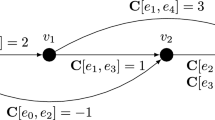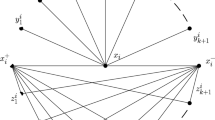Abstract
Given a directed bipartite graph \(G=(V,E)\) with a node set \(V=\{s\} \cup V_1 \cup V_2 \cup \{t\}\), and an arc set \(E=E_1\cup E_2\cup E_3\), where \(E_1=\{s\} \times V_1\), \(E_2= V_1 \times V_2\), and \(E_3=V_2 \times \{t\}\). Chen (1995) presented an \(O(|V| |E| \log (\frac{|V|^2}{|E|}))\) time algorithm to solve the parametric bipartite maximum flow problem. In this paper, we assume all arcs in \(E_2\) have infinite capacity [such a graph is called closure graph Hochbaum (1998)], and present a new approach to solve the problem, which runs in \(O(|V_1| |E| \log (\frac{|V_1|^2}{|E|}+2))\) time using Gallo et al’s parametric maximum flow algorithm, see Gallo et al. (1989). In unbalanced bipartite graphs, we have \(|V_1| << |V_2|\), so, our algorithm improves Chens’s algorithm in unbalanced and closure bipartite graphs.








Similar content being viewed by others
References
Ahuja, R. K., Orlin, J. B., Stein, C., & Tarjan, R. E. (1994). Improved algorithms for bipartite networks flow. SIAM Journal on Computing, 35, 906–933.
Chen, Y. L. (1991). An improved algorithm for scheduling jobs on heterogenuous processors. In National computer symposium (pp. 172–177), Chung-Li, Taiwan.
Chen, Y. L. (1995). A parametric maximum flow algorithm for bipatite graphs with applications. European Journal Operational Research, 80, 226–235.
Cunningham, W. (1985). Optimal attack and reinforcement in a networks. Journal of the ACM, 32, 549–561.
Eisner, M. J., & Severance, D. G. (1976). Mathematical techniques for efficient record segmentation in large shared databases. Journal of the ACM, 23, 619–635.
Faaland, B., & Schmitt, T. (1987). Scheduling tasks with due dates in fabrication/assembly process. Operations Research, 35, 378–388.
Gallo, G., Grigoriadis, M. D., & Tarjan, R. E. (1989). A fast parametric maximum flow algorithm and applications. SIAM Journal on Computing, 18, 30–55.
Goldberg, A.V. (1984). Finding a maximum density subgraph, Berkeley technical report no. UCB/CSD/84/171.
Gusfield, D., Martel, C., & Fernandez-Baca, D. (1987). Fast algorithms for bipartite network flow. SIAM Journal on Computing, 16, 237–251.
Hansen, P., & Simeone, B. (1986). Unimodular functions. Discrete Applied Mathematics, 14, 269–281.
Hochbaum, D.S. (March 1990). On a polynomial class of nonlinear optimization problems, UC Berkeley manuscript.
Hochbaum, D.S. (1998). A framework for half integrality and 2-approximations with applications to feasible cut and minimum satisfiability, UC Berkely manuscript, April 1996. In Jansen and Rolim (Eds.) Extended abstract version in Pro APPROX98, Lecture NOTES in Computer Science 1444 (pp. 99–110). Berlin Heidelberg: Springer-Verlag.
Hochbaum, D. S. (2001). A new-old algorithm for minimum-cut and maximum-flow in closure graphs. Networks, 37, 171–193.
Hochbaum, D. S., Megiddo, N., Naor, J., & Tamir, A. (1993). Tight bounds and 2-approximation algorithms for integer programs with variables per inequality. Mathematical Programming, 62, 69–83.
Hochbaum, D. S., & Naor, J. (1995). Simple and fast algorithms for linear and integer programs with two variables per inequality. SIAM Journal on Computing, 69, 269–309.
Hoffman, A., & Rivlin, J. (1970). When a team is mathematically eliminated? In H. W. Kuhn (Ed.), Princeton Symposium of Math Programming, 1967 (pp. 391–401). Princeton, NJ: Princeton University Press.
Horn, W. (1974). Some simple scheduling algorithms. Naval Research Logistics Quarterly, 21, 177–185.
Karzanov, A. V. (1974). Determining the maximal flow in a network by the method of preflows. Soviet Mathematical Doklady, 15, 434–437.
Lawer, E. L. (1976). Combinatorial optimization: Networks and matroids. New York: Holt Rinehart and Winston.
Malhotra, V. M., Kumar, M. P., & Maheshwari, S. N. (1978). An \(O(|V|^3)\) algorithm for finding maximum flows in networks. Information Processing Letters, 7, 277–278.
Mamer, J.W., & Smith, S.A. (1983). Job completion based inventory systems: Optimal policies for repair kits and spare machines, working paper no. 318, Western Management Science Institue, University of California.
Mcnaughton, R. (1959). Scheduling with deadlines and loss functions. Managment Science, 6, 1–12.
Orlin, D. (1987). Optimal weapons allocation againt layered defenses. Naval Research Logistics, 34, 605–617.
Picard, J. C., & Queyranne, M. (1982). A network flow solution of some nonlinear 0–1 programming problems and applications to graph theory. Networks, 12, 141–159.
Sedeno-Noda, A., Alcaide, D., & Gonzalez-Martin, C. (2006). Networks flow approaches to pre-emptive open-shop scheduling problems with time-windows. Eurpean Journal of Operational Research, 174, 1501–1518.
Sedeno-Noda, A., Alcaide Lopez de Pablo, D., & Gonzalez-Martin, C. (2009). Gonzalez-Martin, Networks flow-based method to solve performance cost and makespan open-shop scheduling problems with time-windows. Eurpean Journal of Operational Research, 196, 140–154.
Schwartz, B. (1966). Possible winners in partially complete tournaments. SIAM Review, 8, 302–308.
Author information
Authors and Affiliations
Corresponding author
Rights and permissions
About this article
Cite this article
Ghiyasvand, M. Solving the parametric bipartite maximum flow problem in unbalanced and closure bipartite graphs. Ann Oper Res 229, 397–408 (2015). https://doi.org/10.1007/s10479-015-1807-7
Published:
Issue Date:
DOI: https://doi.org/10.1007/s10479-015-1807-7




